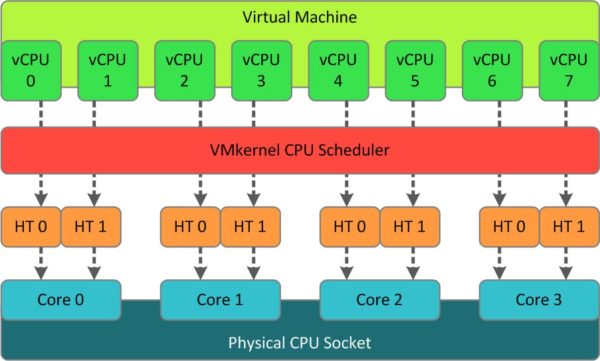What is Hyper-Threading & How Does it Work?
Are you deciding to buy a new Intel Processor?

Are you deciding to buy a new Intel Processor? Want to buy a new computer with an Intel processor installed? You may have heard the term Hyper-Threading. You may not be familiar with this term unless you are a techie. Understanding Hyper-Threading is very important as it is one of the significant features in Intel processor line-ups.
Often, salespersons twist this term at the store you visit to sell the items. Recently I saw an electronic shop near me; the salesperson there told me that Hyper-Threading technology doubles the number of cores on a processor – it’s not true.
Hyper-Threading technology has been on Intel processors for almost ten years, but many people don’t know it! Many people think that Hyper-Threading doubles the processor cores present on the processor. People often ask me this question, so I explained what Hyper-Threading means.
What is Hyper-Threading?
Hyper-Threading Technology (Also called HTT or HT Technology) is Intel’s implementation of simultaneous multithreading (SMT), which uses processor resources more efficiently, enabling multiple threads to run on each core. No matter how many years of research we had in the processor industry, there is one ultimate problem. A single processor core can handle only one thread at a time.
For example, if you are using chrome, MS Word, and Photoshop simultaneously, you might feel like you are multitasking. But in terms of CPU- you are not. The processor only executes one thread of the individual program at a time, but because today's processors are so fast, we won't notice any delay. But there is a tiny bit of time delay after executing one thread and the following thread starting its execution. This delay is mainly caused by scheduling- how each program's lines should be fed to the processor. So, how can we minimize this delay- the answer is "Hyper-Threading."
How Hyper-Threading work?
Hyper-Threading is a form of simultaneous multi-threading (SMT) technology. The concept behind Hyper-Threading is pretty simple. A processor with Hyper-Threading technology enabled consists of two logical processors per core. Each logical processor can work independently- it can be stopped, interrupted, and directed to execute specific threads. This makes it possible to assign processor resources to two individual lines.
As we know, a traditional multi-core system consists of individual physical processors and has different resources. But, in the case of logical processors, it shares the help of a single core. These resources include the system bus interface, caches, and execution engine. This sharing allows the logical processor to interact with each other more effectively. Logical processors can also borrow system resources from another logical processor (when not in use), but both logical processors must be on the same physical core.

Still Didn’t get it? Don’t worry! Let’s take an example; suppose I am a processor – I process food with my mouth. So, I can eat as much as my mouth can chew; I can add more mugs if I need to process more food (this is what multi-core systems are like). But due to some constraints, I can have only one mouth to process food. I use my hand to grab a bite and bring it to my mouth for processing. So, I can process only the amount of food at a time that my writing can get. If I can finish chewing before my hand brings me another bite, my mouth will sit idle- doing nothing (this is what systems without Multi-Threading look like). What should I do to use my mouth effectively? I can use both my hands to bring food to my mouth! So, my mouth will not sit there idle. A system with Hyper-Threading looks like- a single core but intelligent scheduling to ensure that the processor is always working.
Hyper-Threading Doesn’t Doubles Processor Cores.
No matter what Windows Task Manager tells you, Hyper-Threading is not the same as doubling your processor cores. If you boot your quad-core processor with Hyper-Threading support and open your task manager, you will see eight graphs floating around the window. This is where most people get confused.
We see eight graphs on Windows Task Manager because Windows detects eight logical processors- two per core, but the logical processor has no physical existence. Windows can send threads to each logical processor, but only one physical heart still does the execution. So, Hyper-Threading is different than adding a separate physical body.
Benefits Of Hyper-Threading:
If you are using your computer for the things like- web browsing, watching movies, and document editing. You will not notice any impact of Hyper-Threading. Hyper-Threading also can’t improve performance in a single-threaded workload (one thread at a time). But you can observe many performance improvements over a multi-threaded workload. Examples of multi-threaded workloads are:
- Heavy multi-tasking
- Video editing
- 3D rendering
- Scientific applications
According to Intel’s claim, Hyper-Threading can boost performance by up to 30%, although it depends on your work. In some cases, Hyper-Threading provides no boost or, in some instances, slightly decreased performance (depending upon the software).
Conclusion
As we have seen earlier, Hyper-Threading can provide up to a 30% performance boost. But it also has some drawbacks; it increases heat output and power consumption. But there is no need to worry about that, the benefits usually outways this drawback.
We hope that your doubts have been cleared. But do remember:
“Hyper-Threading is NOT the same as doubling your processor cores. “
Share this article with your friends; please comment below if you have any questions. Also, do suggest topics for future posts. Stay tuned for future updates.
Share this article with your friends; please comment below if you have any questions. Also, do suggest the topics for future posts. Stay tuned for future updates.

